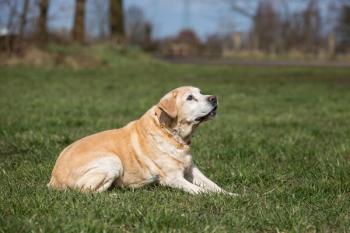
- dvm360 September 2019
- Volume 50
- Issue 9
Surgery STAT: Placing wound soaker catheters in dogs
Veterinary surgeons: Not familiar with wound soaker catheters? Youll want to be. They are easy to place and remove and can simplify your local pain control regimen for some surgical patients.
There's no doubt that the implementation of appropriate analgesic protocols is a vital component of both routine and specialized veterinary surgical care. And yet, systemic analgesics-opioids and nonsteroidal anti-inflammatory medications-while frequently used in the perioperative and postoperative period, can result in unwanted side effects, such as sedation, nausea, vomiting, decreased appetite or urinary retention. Traditional nerve blocks with local anesthetics are beneficial in decreasing systemic analgesic requirements but require technical expertise; additionally, these medications, namely lidocaine and bupivacaine, have relatively short durations of action.
Enter wound infusion catheters (also known as wound soaker or diffusion catheters), which deliver local analgesia to or around a surgical site by using repeated or continuous infusion. The use of these catheters in veterinary medicine has increased with better understanding of and focus on pain management in our patients. Wound soaker catheters are easily placed during surgery, assist in providing local analgesia for a prolonged period, and potentially decrease the need for systemic medications.
Instrumentation
In its simplest form, a wound soaker catheter is a pliable (often polyurethane) catheter that consists of a closed distal tip with small openings along the catheter length, allowing for diffusion of medication along a wound bed (Figure 1). An injection cap or intravenous (IV) administration set can be attached to the proximal end for drug administration.
You can make wound soaker catheters from red rubber or other polyurethane catheters, but other options are commercially available (
Indications
In my experience, wound soaker catheters are used most commonly during forelimb and hindlimb amputations. However, other procedures in which wound soaker catheters are used include thoracotomies, large mass removals and total ear canal ablation.1
Placement
Step 1: Insert the catheter during wound closure (Figure 2). Place the distal tip of the catheter at the deepest layer of closure or desired layer of local anesthetic administration.
Step 2: Continue to close around the catheter, ensuring that all slits are below the skin surface (Figure 3). Pay attention not to suture the catheter to deeper layers.
Step 3: Secure the catheter using a purse string suture and finger trap suture pattern. Commercially available wound soaker catheters have a butterfly at the proximal tip to allow for suturing to the skin and additional support.
Step 4: Cover the exit site with an adherent bandage or soft padded bandage, depending on the placement site.
Step 5: Place an injection port to allow for easy administration of medication. Administer a priming and filtering volume at the time of placement (per specifications supplied with each manufactured catheter).
Step 6: Place an Elizabethan collar on the dog.
Tip: I strongly recommend labeling the patient chart, as well as the cage or run, with reminder signs to ensure that administration of local anesthetic is through the catheter and not the IV.
Analgesia administration
Local anesthetics can be administered through intermittent (bolus) injection or constant-rate infusion. I prefer intermittent injection with bupivacaine, but lidocaine can be given as a constant-rate infusion (approximately 2 mg/kg/hr).
I recommend approximately 1 to 1.5 mg/kg bupivacaine every 4 to 6 hours for dogs. That dose can then be diluted to 0.25% with saline or sterile water to allow for increased volume. Small patients may require additional dilution of drug to ensure all medication exits the catheter or covers the entire wound bed. Limb amputations typically require dilution to ensure adequate dispersion across the wound bed, while thoracotomy procedures may require minimal dilution. Local analgesic can be administered through the catheter for at least 24 hours or longer as indicated.
Note: Wound soaker catheters can be placed in cats. I recommend giving 0.5 mg/kg bupivacaine intermittently for feline patients.
Removal
Removing a wound soaker catheter is simple. Just cut the skin sutures and apply gentle traction.
Complications
Potential complications of wound soaker catheters include seroma, edema, local anesthetic toxicosis, infection or accidental premature removal. One study found no increase in incisional infections in patients receiving wound soaker catheters.2
Conclusion
Wound soaker catheters may provide an additional means of analgesia for surgical patients. They can be placed easily with minimal additional surgical time, while potentially lowering the need for systemic analgesics.
References
- Wolfe TM, Batemen SW, Cole LK, et al. Evaluation of a local anesthetic delivery system for the postoperative analgesic management of canine total ear canal ablation-a randomized, controlled, double-blinded study. Vet Anaesth Analg 2006;33(5):328-339.
- Abelson AL, McCobb EC, Shaw S, et al. Use of wound soaker catheters for the administration of local anesthetic for post-operative analgesia: 56 cases. Vet Anaesth Analg 2009;36(6):597-602.
Additional reading
- Hansen B, Lascelles BD, Thomson A, et al. Variability of performance of wound infusion catheters. Vet Anaesth Analg 2013;40(3):308-315.
- Hardie EM, Lascelles BD, Meuten T, et al. Evaluation of intermittent infusion of bupivacaine into surgical wounds of dogs postoperatively. Vet J 2011;190(2):287-289.
- Radlinsky MG, Mason DE, Roush JK, et al. Use of a continuous, local infusion of bupivacaine for postoperative analgesia in dogs undergoing total ear canal ablation. J Am Vet Med Assoc 2005;227(3):414-419.
Marc Hirshenson, DVM, DACVS, practices at Triangle Veterinary Referral Hospital in Durham, N.C. Aside from his experience with minimally invasive surgery, his professional interests include surgical oncology, wound management, and cruciate ligament disease. In his spare time, he enjoys running, swimming, relaxing on the beach, and spending time with his wife and son.
Surgery STAT is a collaborative column between the American College of Veterinary Surgeons (ACVS) and dvm360 magazine. To locate a diplomate, visit ACVS's
Articles in this issue
over 6 years ago
dvm360, VHMA announce practice manager contest finalistsover 6 years ago
Storm Sangria: A calming cocktail for noise-phobic dogsover 6 years ago
Walk softly and carry a big net: The global fight against rabiesover 6 years ago
A veterinary way with wordsover 6 years ago
Insurance wont cover a DCM diagnosis?over 6 years ago
Cowboy hats and CPR: Why human medicine ain't my rodeoover 6 years ago
Letter to dvm360: Better drug control helpsover 6 years ago
Trupanion wants to save six acres of treesNewsletter
From exam room tips to practice management insights, get trusted veterinary news delivered straight to your inbox—subscribe to dvm360.




